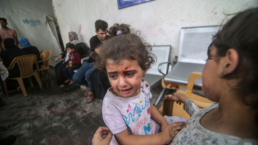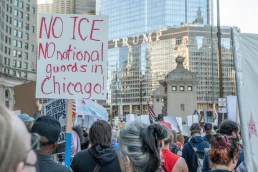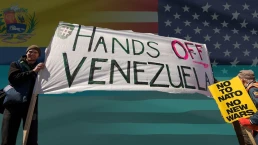Thousands of Jewish activists, saying “Not in Our Name,” have protested the campaign of terror waged by Israel against Palestinians.
By Victor Wallis
U.S. politicians are reluctant to call even for a cease-fire in Gaza, let alone for an end to Israeli occupation of Palestinian territories. There are gaps in underlying public awareness that cry out to be filled.

- Scope of the destruction. This may be widely known in general terms, but few reports convey from close up the scope of the suffering in Gaza, which includes not only the numbers already killed or uprooted, but also the intentional blocking or destruction of basic resources necessary to life. Even those who are not killed by bombs are condemned by lack of water, food, shelter, and sanitation. The psychological trauma, especially for children, is incalculable.
- Why the Palestinian attack of October 7? Corporate media constantly remind us of this attack but say next to nothing about what provoked it. They do not allude to the restrictive conditions under which Gazans had lived for seventeen years prior to that date. Nor, more importantly did they report on the steady escalation of Israeli attacks, prior to October 7, on Palestinians living in the West Bank, with some 200 killed in 2023 alone.
- The Gazans tried nonviolence. While the armed attack of October 7 regrettably took civilian lives, we should remember the “Great March of Return” – weekly peaceful protests of more than 10,000 Palestinians at the Israel/Gaza border, from March 2018 through December 2019, which were met by gunfire from Israeli troops, killing over 200 civilians and wounding over 36,000.
- Captives. Corporate media understandably remind us of the 1,200 Israelis killed and the 240 captured on October 7. But they do not mention the thousands of West-Bank Palestinians held in Israeli prisons, often without charges or merely for engaging in peaceful protests. Israeli prime minister Benjamin Netanyahu says that for him to halt the bombing, Hamas would first have to release all the Israelis they are holding. But instead of bombing Gaza, he could have negotiated their release through a prisoner swap. As it is, Israeli forces themselves have killed Jewish captives, not only through bombs dropped on them in Gaza, but also by indiscriminate shelling, on October 7, of Israeli homes taken over by Palestinian fighters.
- Double standards. While we are expected to condemn the October 7 killings of Jews by Palestinians, we are expected to ignore the 1948 killings and deportations of Palestinians by Jews that, by shifting the demographic balance, created the basis for a Jewish State. The Zionist leaders’ ordering of the 1948 killings is fully documented by Israeli historian Ilan Pappe in his 2008 book,The Ethnic Cleansing of Palestine. Subjugation of the Palestinians continued within Israel and, after 1967, in the Occupied Palestinian territories, which are permeated by Israeli checkpoints and military patrols, facilitating attacks by Jewish settlers on Palestinian civilians. (Pappe’s shorter 2017 book, Ten Myths about Israel, provides an excellent introduction to the whole history.)
- Conflating critique of Israel with antisemitism. Contrary to claims by the Israeli government and repeated by U.S. political leaders and corporate media, it is not antisemitic to reject the Zionist agenda (see Jerusalem Declaration on Antisemitism, https://jerusalemdeclaration.org/). Thousands of Jewish activists, saying “Not in Our Name,” have protested the campaign of terror waged by Israel against Palestinians.
This article is adapted from a flyer. Victor Wallis’s books include “Democracy Denied: Five Lectures on U.S. Politics” (Africa World Press, 2019) and “Socialist Practice: Histories and Theories” (Palgrave Macmillan, 2020).
Recent Posts
“The Blue Road To Trump Hell”: Norm Solomon On “How Corporate Democrats Paved The Way For Autocracy”
December 31, 2025
Take Action Now “If you don’t examine real history, then you’re in a cycle that repeats the same problems,” says Norman Solomon, director of…
Why is the Democratic party hiding its 2024 autopsy report?
December 30, 2025
Take Action Now If the DNC isn’t open and transparent about why they lost, then how can we be sure they will learn their lesson this time?By…
Anti-ICE Resistance Sprang Up Across Red States In 2025
December 29, 2025
Take Action Now In Texas, North Carolina, Alabama, Tennessee, Florida, and beyond, grassroots resistance to ICE is growing.By Sonali Kolhatkar,…
Trump Suggests US Bombed ‘Big Facility’ in Venezuela. No One Seems to Know What He’s Talking About
December 29, 2025
Take Action Now Administration officials have yet to provide any details about the supposed strike, which would mark a massive escalation in the…




